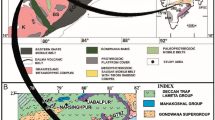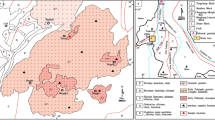Abstract
Kharchinsky and Zarechny volcanoes and the Kharchinsky Lake zone of monogenic cones are unique eruptive centers of magnesian lavas located above the northern margin of the Pacific plate subducting beneath Kamchatka. This paper presents new geochemical data on the composition of rocks (55 samples) and minerals (over 900 analyses of olivine, pyroxenes, amphibole, and plagioclase) of these centers analyzed by XRF and LA-ICP-MS (rocks) and electron microprobe (minerals). Most of the studied rocks are magnesian (Mg# = 60–75 mol %) medium-K basalts and basaltic andesites. Moderate-magnesian (Mg# = 52–59 mol %) basaltic andesites are present among the monogenic cones of Kharchinsky Lake. The rare rock varieties include the high-K basalts–basaltic andesites of dikes in the center of Kharchinsky volcano and the magnesian andesites (Mg# = 58–61 mol %) of the extrusions of Zarechnу volcano. The distribution of trace-element contents in these samples demonstrates enrichment in large-ion lithophile elements and light REEs at depletion in high field strength elements and heavy REEs, as is typical of arc rocks. The high-K basalts and basaltic andesites show anomalous enrichment in Ba (>1000 ppm), Th (>3.8 ppm), U (>1.8 ppm), Sr (> 800 ppm, Sr/Y > 50), and light REE (La > 20 ppm), and their compositions are close to those of low-Si adakites. The basalts and basaltic andesites contain phenocrysts of high-Mg olivine (up to Fo92.6) and clinopyroxene (Mg # up to 91 mol %). The rocks show petrographic and geochemical evidence of fractional crystallization, along with the processes of mineral accumulation and magma mixing. Some of the olivine phenocrysts show high NiO contents (up to 5000 ppm) and an elevated Fe/Mn ratio (up to 80), which were interpreted as evidence of the participation of a pyroxenite source in the magma generation processes. The use of the Ca/Fe and Ni/Mg ratios allowed us to distinguish the composition fields and evolution trends of olivine associated with different sources: peridotite and pyroxenite, which were formed by a reaction between mantle-wedge peridotites and high-Si melts of the subducted oceanic crust. The new data are consistent with other lines of evidence of melting of the subducted Pacific plate edge beneath the northern part of the Central Kamchatka Depression at the Kurile–Kamchatka and Aleutian subduction zone junction and testify to a significant heterogeneity of the mantle in this area.









Similar content being viewed by others
Notes
Supplementary materials for the Russian and English versions of this paper are available at https://elibrary.ru/ and http://link.springer.com/, respectively, and in Supplementary 1: ESM_1.xlsx: analyses of the secondary standards for XRF analysis; ESM_2.xlsx: analyses of the secondary standards for ICP-MS analysis; ESM_3.xlsx: analyses of the secondary standards for microprobe (EPMA) analysis; ESM_4.xlsx: whole-rock compositions of the samples; ESM_5.xlsx: composition of olivine phenocrysts in the samples; ESM_6.xlsx: composition of pyroxene phenocrysts in the samples; ESM_7.xlsx: composition of amphibole phenocrysts in the samples; ESM_8.xlsx: composition of plagioclase phenocrysts in the samples.
Mineral symbols are according to (Whitney and Evans, 2010).
REFERENCES
Bryant, J.A., Yogodzinski, G.M., and Churikova, T.G., High-Mg# andesitic lavas of the Shisheisky Complex, northern Kamchatka: implications for primitive calc-alkaline magmatism, Contrib. Mineral. Petrol., 2011, vol. 161, no. 5, pp. 791–810.
Churikova, T., Dorendorf, F., and Wörner, G., Sources and fluids in the mantle wedge below Kamchatka, evidence from across-arc geochemical variation, J. Petrol., 2001, vol. 42, no. Iss. 8, pp. 1567–1593.
Defant, M.J. and Drummond, M.S., Derivation of some modern arc magmas by melting of young subducted lithosphere, Nature, 1990, vol. 347, pp. 662–665.
Gavrilenko, M., Herzberg, C., Vidito, C., et al., A calcium-in-olivine geohygrometer and its application to subduction zone magmatism, J. Petrol., 2016, vol. 57, no. 9, pp. 1811–1832.
Gill, R., Igneous Rocks and Processes: a Practical Guide, John Wiley & Sons, 2011.
Gorbach, N.V. and Portnyagin, M.V., Geology and petrology of the lava complex of young Shiveluch Volcano, Kamchatka, Petrology, 2011, vol. 19, no. 2, pp. 134–166.
Gorbach, N., Portnyagin, M., and Tembrel, I., Volcanic structure and composition of old Shiveluch Volcano, Kamchatka, J. Volcanol. Geotherm. Res., 2013, vol. 263, pp. 193–208.
Gorbach, N., Philosofova, T., and Portnyagin, M., Amphibole record of the 1964 Plinian and following dome-forming eruptions of Shiveluch Volcano, Kamchatka, J. Volcanol. Geotherm. Res., 2020, vol. 407, p. 107108.
Gordeychik, B., Churikova, T. Shea, T., et al., Fo and Ni relations in olivine differentiate between crystallization and diffusion trends, J. Petrol., 2020, vol. 61, no. 9. https://doi.org/10.1093/petrology/egaa083
Govindaraju, K., Compilation of working values and sample description for 383 geostandards, Geostand. Newslett., 1994, vol. 18, pp. 1–158.
Herzberg, C., Identification of source lithology in the Hawaiian and Canary islands: implications for origins, J. Petrol., 2011, vol. 52, no. 1, pp. 113–146.
Herzberg, C., Asimow, P.D., Ionov, D.A., et al., Nickel and helium evidence for melt above the core–mantle boundary, Nature, 2013, vol. 493, no. 7432, pp. 393–397. https://doi.org/10.1093/petrology/egaa083
Jarosewich, E., Nelen, J.A., and Norberg, J.A., Reference samples for electron microprobe analysis, Geostand. Newslett., 1980, vol. 4, pp. 43–47.
Jochum, K.P., Weis, U., Schwager, B., et al., Reference values following ISO guidelines for frequently requested rock reference materials, Geostand. Geoanalyt. Res., 2016, vol. 40, no. 3, pp. 333–350.
Kutyev, F.Sh. and Erlikh, E.N., Petrology of basalts of the Kharchinsy volcano group, Byull. Vulkanol. Stantsii, 1973, vol. 49, pp. 83–92.
Leake, B.E., Woolley, A.R., Arps, C.E.S., et al., Nomenclature of amphiboles: report of the subcommittee on amphiboles of the mineralogical association, Mineral. Mag., 1997, vol. 61, no. 3, pp. 295–321.
Lindsley, D.H., Pyroxene thermometry, Am. Mineral., 1983, vol. 68, nos. 5–6, pp. 477–493.
Martin, H., Adakitic magmas: modern analogues of Archaean granitoids, Lithos, 1999, vol. 46, no. 3, pp. 411–429.
Martin, H., Smithies, R.H., Rapp, R., et al., An overview of adakite, tonalite–trondhjemite–granodiorite (TTG), and sanukitoid: relationships and some implications for crustal evolution, Lithos, 2005, vol. 79, nos. 1–2, pp. 1–24.
Menyailov, A.A., Volcanoes of Kharchinsky Mounts, Tr. Lab. Vulkanologii, 1949, vol. 6, pp. 53–61.
Moyen, J.F., High Sr/Y and La/Yb ratios: the meaning of the “adakitic” “signature”, Lithos, 2009, vol. 112, nos. 3–4, pp. 556–574.
Münker, C., Wörner, G., Yogodzinski, G.M., and Churikova, T., Behaviour of high field strength elements in subduction zones: constraints from Kamchatka–Aleutian arc lavas, Earth Planet. Sci. Lett., 2004, vol. 224, pp. 275–293.
Nekrylov, N., Portnyagin, M.V., Kamenetsky, V.S., et al., Chromium spinel in Late Quaternary volcanic rocks from Kamchatka: implications for spatial compositional variability of subarc mantle and its oxidation state, Lithos, 2018, vol. 322, pp. 212–224.
Nekrylov, N., Kamenetsky, V.S., Savelyev, D.P., et al., Platinum-group elements in Late Quaternary high-Mg basalts of eastern Kamchatka: evidence for minor cryptic sulfide fractionation in primitive arc magmas, Lithos, 2022, nos. 412–413, p. 106608.
Nikulin, A., Levin, V., Carr, M., et al., Evidence for two upper mantle sources driving volcanism in central Kamchatka, Earth Planet. Sci. Lett., 2012, vol. 321–322, pp. 14–19.
Nimis, P. and Ulmer, P., Clinopyroxene geobarometry of magmatic rocks part 1: an expanded structural geobarometer for anhydrous and hydrous, basic and ultrabasic systems, Contrib. Mineral. Petrol., 1998, vol. 133, no. 1, pp. 122–135.
Nishizawa, T., Nakamura, H., Churikova, T., et al., Genesis of ultra-high-Ni olivine in high-Mg andesite lava triggered by seamount subduction, Sci. Rept., 2017, vol. 7, no. 1, p. 11515.
Ogorodov, N.V. and Belousov, V.I., New data on the Kharchinsky and Zarechny volcanoes, Byull. Vulkanol. Stantsii, 1961, vol. 31, pp. 46–51.
Petrograficheskii kodeks Rossii. Magmaticheskie, metamorficheskie, metasomaticheskie, impaktnye obrazovaniya (Petrographic Code of Russia. Magmatic, Metamorphic, Metasomatic, and Impact Rocks), Bogatikov, O.A., Petrov, O.V., Sharpenok, L.N., Eds., St. Petersburg: VSEGEI, 2008.
Ponomareva, V., Pendea, I.F., Zelenin, E., et al., The first continuous Late Pleistocene tephra record from Kamchatka Peninsula (NW Pacific) and its volcanological and paleogeographic implications, Quatern. Sci. Rev., 2021, vol. 257, p. 106838. https://doi.org/10.1016/j.quascirev.2021.106838
Portnyagin, M., Bindeman, I., Hoernle, K., and Hauff, F., Geochemistry of primitive lavas of the Central Kamchatka Depression: magma generation at the edge of the Pacific Plate, Volcanism and Subduction: The Kamchatka Region, Eichelberger, J., Gordeev, E., Kasaharaet, M., et al., Eds., Am. Geophys. Union, Geophys. Monogr., 2007, vol. 172, pp. 199–239.
Portnyagin, M.V., Sobolev, A.V., Mironov, N.L., and Hoernle, K., Pyroxenite melts involved in magma genesis in Kamchatka, 19th Annual VM Goldschmidt Conference, Davos, Switzerland, Geochim. Cosmochim. Acta, 2009, vol. 73, no. 13, Suppl. 1, A1044.
Portnyagin, M.V., Mironov, N.L., and Nazarova, D.P., Copper partitioning between olivine and melt inclusions and its content in primitive island-arc magmas of Kamchatka, Petrology, 2017, vol. 25, no. 4, pp. 419–433.
Sekisova, V.S., Smirnov, S.Z., Kuzmin, D.V., et al., Crust–mantle xenoliths from the Kharchinsky Volcano (Central Kamchatka depression): Mineralogy and petrogenesis, Russ. Geol. Geophys., 2021, vol. 62, no. 3, pp. 339–356.
Siegrist, M., Yogodzinski, G., Bizimis, M., et al., Fragments of metasomatized forearc: origin and implications of mafic and ultramafic xenoliths from Kharchinsky Volcano, Kamchatka, Geochem. Geophys. Geosyst., 2019, no. 9, pp. 4426–4456.
Siegrist, M., Yogodzinski, G.M., and Bizimis, M., Origins of Os-isotope and platinum-group element compositions of metasomatized peridotite and cumulate pyroxenite xenoliths from Kharchinsky Volcano, Kamchatka, Geochim. Cosmochim. Acta, 2021, vol. 299, pp. 130–150.
Simakin, A.G., Devyatova, V.N., Salova, T.P., and Shaposhnikova, O.Yu., Experimental study of amphibole crystallization from the highly magnesian melt of Shiveluch Volcano, Kamchatka, Petrology, 2019, vol. 27, no. 5, pp. 442–459.
Sobolev, A.V., Hofmann, A.W., Kuzmin, D.V., et al., The amount of recycled crust in sources of mantle-derived melts, Science, 2007, vol. 316, no. 5823, pp. 412–417.
Straub, S.M., LaGatta, A.B., Pozzo, A.L.M.D., and Langmuir, C.H., Evidence from high-ni olivines for a hybridized peridotite/pyroxenite source for orogenic andesites from the central mexican volcanic belt, Geochem. Geophys. Geosyst., 2008, no. 9. https://doi.org/10.1029/2007GC001583
Sun, S.S. and McDonough, W.F., Chemical and isotopic systematics of oceanic basalts: implications for mantle composition and processes, Geol. Soc. London, Spec. Publ. 1989, vol. 42, no. 1, pp. 313–345.
Volynets, O.N., Melekestsev, I.V., Ponomareva, V.V., and Yagodzinski, J.M., Kharchinsky and Zarechny volcanoes—unique centers of Late Pleistocene magnesian basalts at Kamchatka: structural control, morphology, age, and geological structure of the volcanoes, Vulkanol. Seismol., 1998, nos. 4–5, pp. 5–18.
Volynets, O.N., Melekestsev, I.V., Ponomareva, V.V., Yagodzinski, J.M., Kharchinsky and Zarechny volcanoes—unique centers of Late Pleistocene magnesian basalts at Kamchatka: composition of volcanic rocks, Vulkanol. Seismol., 1999, no. 1, pp. 31–45.
Volynets, O.N., Babanskii, A.D., and Gol’tsman, Yu.V., Variations in isotopic and trace-element composition of lavas from volcanoes of the Northern Group, Kamchatka, in relation to specific features of subduction, Geochem. Int., 2000, vol. 38, no. 10, pp. 974–989.
Volynets O.N., Ponomareva V.V., Babanskii A.D. Magnesian basalts of Shiveluch andesite volcano, Kamchatka, Petrology, 1997, vol. 5, no. 2, pp. 183–196.
Whitney, D.L. and Evans, B.W., Abbreviations for names of rock-forming minerals, Am. Mineral., 2010, vol. 95, no. 1, pp. 185–187.
Yogodzinski, G.M., Lees, J.M., Churikova, T.G., et al., Geochemical evidence for the melting of subducting oceanic lithosphere at plate edges, Nature, 2001, vol. 409, pp. 500–504.
ACKNOWLEDGMENTS
The authors thank O.A. Khleborodova for preparing the samples for chemical analysis, conducting high-temperature melting of rock powders, and carrying out microprobe analyses. The fieldwork aimed at sampling the bottom part of Zarechny volcano and auxiliary cones of Kharchinsky volcano was conducted under the joint Russian–German research project KOMEX-2 with the participation of N.L. Mironov, A.B. Belousov and O.A. Khleborodova. The authors are grateful to S.Z. Smirnov for constructive criticism that led us to present a better argumentation in support of some of the conclusions and improve the manuscript.
Funding
KOMEX-2 Project was financed by the Ministry for Science and Education of Germany. This study was finished under Russian government-financed research project 0282-2019-0004 for the Institute of Volcanology and Seismology, Far Eastern Branch, Russian Academy of Sciences, Petropavlovsk-Kamchatsky,
Author information
Authors and Affiliations
Corresponding author
Ethics declarations
The authors declare that they have no conflicts of interest.
Additional information
Translated by E. Kurdyukov
Supplementary Information
Rights and permissions
About this article
Cite this article
Gorbach, N.V., Nekrylov, N.A., Portnyagin, M.V. et al. New Data on the Rock and Mineral Composition of Kharchinsky and Zarechny Volcanoes, Central Kamchatka Depression: Heterogeneity of the Mantle Source and Peculiarities of Magma Evolution in the Crust. Petrology 31, 320–337 (2023). https://doi.org/10.1134/S0869591123030050
Received:
Revised:
Accepted:
Published:
Issue Date:
DOI: https://doi.org/10.1134/S0869591123030050




